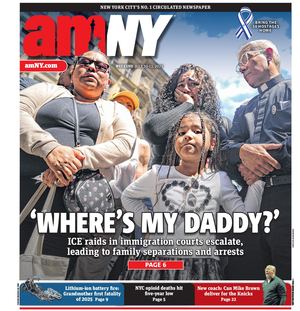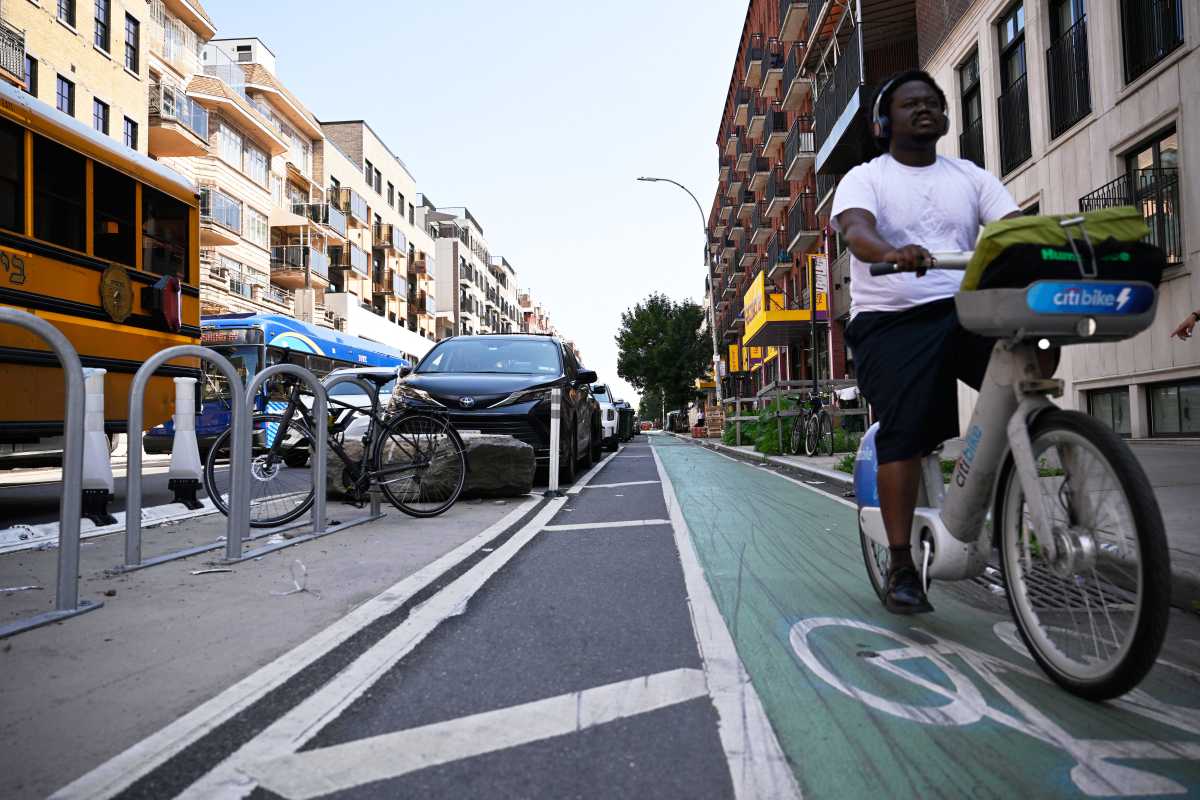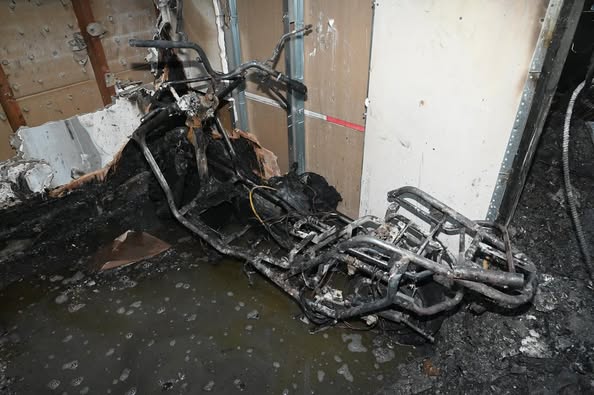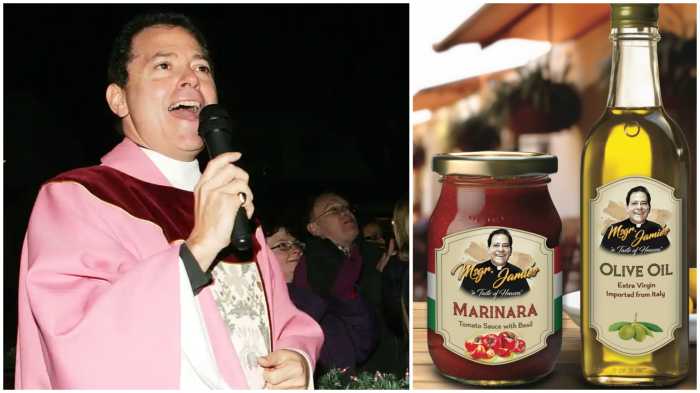Shades of ‘Emperor Moses’
To The Editor: As eager Greenwich Village residents prepared for the highly anticipated court hearing for the city’s appeal over the future of Washington Square Park on Oct. 31, it is prudent perhaps to reflect on history and realize that this is a very familiar story.
On Dec. 19, 1934, in the middle of the Great Depression, The Villager first broke the story that Parks Commissioner Robert Moses planned to “dress” Washington Square Park in some new clothes. The article assured readers that the new plan would “renew and replenish the pride which is in Village hearts for this grand old open space,” but before long, Village residents were in an uproar.
The landscape plan, which was published on the front page of The Villager on March 14, 1935, planned to stamp out all vestiges of the 1870 design (which is still visible in today’s park) and create a “formal garden” of sorts. A major point of the plan was the removal the park’s beloved fountain and the creation of a rectangular reflecting pool which was intended to lie in the exact center of the park, perfectly in line with the arch.
For those familiar with the most controversial aspect of the redesign proposal introduced by the Parks Department in 2004 (the part where the fountain is to be moved into exact line with the arch) this is an almost farcical case of history repeating itself. Washington Square Park is repeatedly being given new clothes — but it seems only the nearby residents realize that if the park dons these new clothes they will be nothing more than what they were for the emperor of the famous children’s tale — a “birthday suit” in the worst sense.
The moral, of course, in the story of “The Emperor’s New Clothes” was that people sometimes follow their leaders to outrageously foolish lengths. It is quite obvious that Village residents are marching to their own tune; but perhaps if everyone, including the Parks Department, takes a step back and reassesses the why of this case, maybe in the light of history we could come up with some new conclusions and make Washington Square Park the public space we all deserve.
Lindsay Miller Miller, a graduate student at Columbia University in the Graduate School of Architecture, Planning, and Preservation, is doing a thesis on Washington Square Park and public advocacy.
Great courtroom drama
To The Editor: Re “Peripatetic Living Theater lives again on L.E.S.” (news article, Oct. 13):
I remember Judith Malina but not only in connection with the theater. I saw “The Connection” and “The Brig,” of course. But at 100 Centre St., at night court, I recall correctly, I think, when she was arrested with a score of others for protesting air raid drills. Air raid drills? Yes! They were still going on in preparation for the war the Reds — Socialist Soviets — were making on us.
Judith was in distinguished (antiwar) company, which included Dorothy Day, A.J. Muste, Dave Dellinger, Ammon Hennessy, Eileen Fantino, Mary Ann McCoy and others. And they all sat conspicuously out of doors together and refused to take shelter in an air raid shelter; their position was that these air raid drills were being perpetuated to promote war fever. And Ammon and Dorothy and Dave and others had gone to jail from their youth to protest war-making.
Mike Harrington and I, who had been at the Catholic Worker at the same time a couple of years before and were contributing to Commonweal, walked over from the White Horse to 100 Centre St. in the warm late-spring evening. Did we really walk? It seemed like a stroll. And in the night court — it seemed like a great hall — Mike remarked that whenever he entered a courtroom he automatically became an anarchist. (He was, of course, the premier American Socialist after the death of Norman Thomas.) And we sat 20 rows back, at the side. The about-to-be-judged antiwar protesters were brought in, and stood in a long, informal line across the well of the court while the judge — forget his name — quietly attended to his paperwork.
Judith Malina and Eileen Fantino were standing together to the left of the bench and were quietly chatting and tittering. The judge looked up and sharply reprimanded them, but Judith didn’t allow it to pass and gave him a spunky riposte. Immediately, loudly, the judge ordered her arrested by court officers, who advanced to take hold of her, which she resisted and screamed. Buy this time, the courtroom was filled with supporters and spectators, and we rose to our feet. Judith’s husband, who was among us in the citizens’ seats, went into the center aisle, crying out her name — full stage voice — a tall, slender man, and, of course, he was seized by court officers, and the judge barked out another order and within minutes the immense courtroom was lined with cops, standing literally shoulder to shoulder around the four walls. Judith was literally carried out. The court was cleared. Michael and I returned to the White Horse.
John Stanley
Time to ground heliport
To The Editor: Re “Heliport on Hudson still flying high after 50 years” (news article, Oct. 13):
I was very disturbed by your biased article sanctifying the heliport at W. 30th St., which is owned by the politically and financially well-connected Trenk family. You reported that the heliport’s small dock is one of the busiest heliports in the world, open around the clock, seven days a week. To be clear, the helicopters’ terrible noise and pollution, the disturbance of the Hudson’s fragile ecosystem and the constant threat to the safety of Manhattan airspace is no cause for celebration! This type of economic activity killed the very purpose of the Hudson River Park, especially since the heliport sits next to a newly created wildlife sanctuary.
It was also shocking to hear former public officers like Betsy McCaughey and Robert Balachandran, the former C.E.O. and president of the Hudson River Park Trust, and Vince McGowan speak like paid lobbyists in favor of the heliport. They betrayed their mission to keep the park quiet and beautiful for everyone to enjoy without being exposed to the obnoxious presence of dozens of helicopters hovering around like in a war zone. It’s time for the nearby residents and other friends of the Hudson River Park to organize a coalition demanding the immediate closure of the W. 30th St. heliport. Why was the lease renewed and who authorized the renewal? The answer to this question should be open to public scrutiny. The completion of the park must be an absolute priority and should not be delayed any longer by a heliport sitting right smack in its middle.
Gilbert Christopher
20 questions for Benepe
To The Editor: Rumors of a conservancy planned for Washington Square Park got some credence with the release of an environmental assessment study. While few people have seen it, the study apparently not only posits such a conservancy, but is specific as to budget and staffing. Here are some questions for Parks Department Commissioner Adrian Benepe regarding this proposed conservancy and conservancies in general.
1. How does a conservancy get started…surely not spontaneously? Are you the decider?
2. Do you first get consensus from the community?
3. Procedurally, do you identify moneyed groups and invite them to come aboard?
4. Or do moneyed groups approach you with an offer?
5. Suppose there are competing park manager wannabes? Do you have a bidding war?
6. What if local groups and officials oppose this? Do you plunge ahead anyway?
7. What are the duties and obligations of a conservancy?
8. What would be the relationship to the community board?
9. If people have problems, do they reach out to the commissioner or to the conservancy?
10. Your Washington Square Park assessment indicates that you have given this matter some thought. We know there has been no consultation with the board, but are there special people in the community you’ve spoken to? Who?
11. Would some of the paid posts envisioned be for people who raise funds?
12. Would it not be preferable to allocate such funds to the Parks Department’s budget?
13. Speaking of budgets, when did you last make a case for more funding for Parks?
14. Hasn’t the Parks budget declined from 1.4 percent of the total budget in 1960 to less than ½ of 1 percent in 2006-’07?
15. Hasn’t this cut resulted in a drastic shortfall in maintenance?
16. Hasn’t the recreation staff been badly decimated?
17. Doesn’t the City Charter spell out the obligation of the city to provide certain services, and isn’t the proper maintenance of our park system included?
18. What happens to parks in poor neighborhoods that can’t afford a conservancy? Does anyone believe that there aren’t broken benches, potholed ball fields and litter pileups in parks in these areas?
19. Isn’t it true that there are no rules, no guidelines covering the establishment and operations for private entities that manage parks?
20. Wouldn’t it make sense to stop and consider the policy implications of these conservancies, as well as the practical aspects of accountability to the city and the community, before authorizing the establishment of any new conservancies?
Carol Greitzer
Greitzer was city councilmember for the Village, Chelsea and Midtown from 1969-’91
To The Editor:
Re “Wiring debate has nothing to do with cable or ’Net” (news article, Oct. 25):
I read the article by Marvin Greisman on a Manhatten eruv and I have two questions/comments:
The article states, “And, furthermore, congregations below 57th St. also wanted eruvs in their respective communities, so they got together and established eruvs from below 57th St. down to Houston St.” I would like to know the basis for this statement. I visit the area bounded by Avenue C, 14th St., Third Ave. and 23rd St. and have been told that there is no longer an eruv there, so I would be very interested in learning that it has been restored. It would make my Sabbath visits a lot easier! Also, this is not only an Orthodox issue. Many Conservative Jews (such as myself) also believe that they are prohibited from carrying on the Sabbath in the absence of an eruv. An eruv, in my opinion, is a necessary condition for a dynamic, growing, observant Jewish community. Robert L. Smith
To The Editor:
“Seminary must survive for gay rights and for Chelsea” (talking point, by Matt Foreman, Oct. 18):
I am writing this letter to correct factual inaccuracies in Matt Foreman’s talking point. Since Mr. Foreman is a very good friend of Maureen Burnley, C.F.O. of the General Theological Seminary, it is a shame he did not let her correct the errors before he submitted it for publication. The quotes that follow are his, the answers are mine: “It is burdened by the enormous cost of maintaining dozens of historic buildings.” There are 20 buildings on the campus, not dozens.
“Residents of the 15-story building across the street denounce the seminary as violating the scale of the avenue for proposing a building that is the exact same height as their own.” The 15-story building across the street was built in 1929, prior to the height zoning limits, and has less than half the bulk of the new Sherrill Hall. “…[W]hen Chelsea was redlined in the 1960s and 1970s, the seminary provided deeply discounted mortgages for scores of the very same townhouses these landowners now enjoy.” Scores of houses? How about some? The seminary later reneged on a few of these proposed mortgages. Many institutions assist their neighbors who cannot obtain mortgages on their own, so that they can make needed repairs, and also in order to preserve the institution’s property values. “…[I]t would be better to have a big-box store on Ninth Ave., than to give G.T.S. an inch.” This is a base canard that the seminary has been trying to promote. No one wants big-box stores on the Ninth Ave. frontage of the seminary. Quality shops, which now can get high rentals, were proposed as a way the seminary could have a continuous revenue stream. That and several other sound alternative proposals were rejected by the seminary, which refuses to budge from a disadvantageous deal with its developer. Robert Trentlyon
Trentlyon is president, Save Chelsea Historic District
To The Editor:
The East Village Community Coalition thanks The Villager for its coverage of the Department of City Planning’s proposed rezoning of part of the Lower East Side and East Village. This rezoning has profound consequences for the future of our neighborhood. We recently sent City Planning a letter thanking them for their work on this badly needed rezoning, but raising a few concerns. City Planning’s proposal, while bringing most “community facility” development into line with the existing neighborhood scale, still unfairly gives extra bulk to nonprofit residences for the elderly, something that could encourage the destruction of treasured buildings for this use, though we certainly support affordable housing for the elderly and others. Certain corridors are so dramatically upzoned as to create huge incentives to push people and businesses out and demolish sound buildings. All along these R8A corridors, building to roughly the size of the Avalon Chrystie building would be allowed. Upzoning these corridors may make sense, but not to this extent. The R7A zoning envelope proposed for most of the neighborhood is generally a good fit. However, some particularly worthwhile midblocks would benefit greatly from slightly lower R7B zoning. It would come at very little cost to overall opportunity for growth. We also endorse the Community Board 3 Rezoning Task Force’s concerns in calling for antidemolition and antiharassment measures, in calling for the rezoning of some areas below Houston St. from commercial to residential, and in opposing any commercial overlays on St. Mark’s Pl. We hope that community members pay attention to this rezoning proposal. We believe that those who do will share our conclusion that this proposal is good in broad conception, but could be tweaked in a few ways to be truly fantastic for our neighborhood and city. Our full letter to City Planning can be found on our Web site at https://www.evccnyc.org.
Aaron Sosnick
Sosnick is a member, East Village Community Coalition
E-mail letters, not longer than 350 words in length, to news@thevillager.com or fax to 212-229-2790 or mail to The Villager, Letters to the Editor, 145 Sixth Ave., ground floor, NY, NY 10013. Please include phone number for confirmation purposes. The Villager reserves the right to edit letters for space, grammar, clarity and libel.Wired in the old sense
Foreman flubs the facts
Rezoning needs tweaking

































